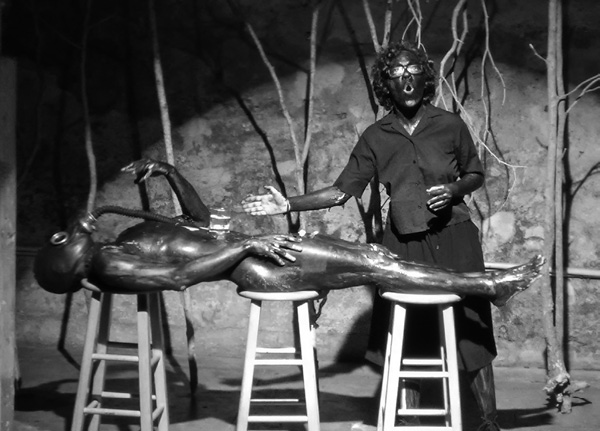
VENUS Y EL ALBAÑIL
first performed on June 24, 2016
Casa Cruz de la Luna, San Germán, Puerto Rico
performed three times in 2016
CASA CRUZ DE LA LUNA THEATRE
Nara Mansur, Alejandra Maldonado, Christopher Cancel, Aravind Enrique Adyanthaya
San Germán, Puerto Rico / Brooklyn, NY
379891793c379891793a379891793s379891793a379891793c379891793r379891793u379891793z379891793d379891793e379891793l379891793a379891793l379891793u379891793n379891793a379891793@379891793y379891793a379891793h379891793o379891793o379891793.379891793c379891793o379891793m
casacruzdelaluna.com
VENUS Y EL ALBAÑIL
CASA CRUZ DE LA LUNA THEATRE
“Venus y el Albañil” (“Venus and the Mason”) is a dramatic poem by contemporary Cuban writer Nara Mansur Cao. It dwells on the moment when a young woman (‘I’) is waiting in a hospital for news on the health of her mother, who has been raped by a mason who was working on their house in a suburb of La Habana.
How do we live through a violent act? How do we materialize the insistent violence of memory? How do we approach the complexity of Caribbean society in a text that blurs differences between the biographical and the fictional, the identity of victim and aggressor, the quotidianity of living in Cuba and violent dystopic images of the city, the humour and the poignancy of non sequiturs; a text that lies between a cry, confession, and revolt?
In the performance we attempted to translate this conflictive fluidity through the use of various embodied styles (melodramatic exaggeration, performative viscerality, symbolist stillness and monotone, lecture delivery, and casual realism), and an interplay of diverse materialities (hanging tree trunks, fruits, dead and living animals, present bodies, bodies in pornographic films and stylized ceremonies, prerecorded words, words written live, and echoes). Issues of race—inherent in the recurrent identification of the assailant as a black man—were further problematized as the two actors were completely painted in black, naked during most of the performance. A practice of encounter—a process of witnessing interiorities, partaking of an event —was enacted as audience members were physically moved, alternately occupying their seats and sitting onstage (listening to the woman), eating pork in a feast, reading from the script alone in singular enclosures, standing, squeezing oranges over each other and peeling the paint from the male body.
The piece opened as the public, one by one, entered into the space and were welcomed into an individual, lighted enclosure, surrounded by a sleeping net. Once in the space, each participant read the author’s introduction:
“This work is about you and me, our thoughts. Our morals, which is to say, our political beliefs, our faith.”
The work was a ritual of healing that never reached a conclusion, but stayed in a realm of active intent/desire. Our production did not try to answer questions, but instead potentiate the dissonances in the experiential: the inability to separate sudden pain from the pulsation of life.